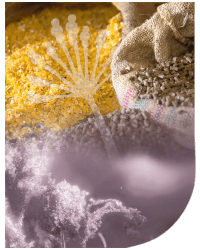Prof. Simon Jackson
Molendotech Ltd., Devon, UK
What are endotoxins?
Endotoxins are major components of the outer membrane of Gram-negative bacteria.
⇰ They are composed of a lipid anchor, termed lipid A, and a polysaccharide repeating unit. Due to the structure, endotoxins are also known as lipopolysaccharides (LPS) (Figure 1).

Figure 1. Schematic structure of endotoxin from E. coli. (Adapted from Abate et al., Journal of Medical Microbiology, 2017).
 Endotoxins increase the negative charge of the cell membrane and help to stabilize the overall membrane structure forming an effective permeability barrier against small, hydrophobic molecules making Gram-negative bacteria innately resistant to many antimicrobial compounds.
Endotoxins increase the negative charge of the cell membrane and help to stabilize the overall membrane structure forming an effective permeability barrier against small, hydrophobic molecules making Gram-negative bacteria innately resistant to many antimicrobial compounds.While the overall structure of endotoxin is similar among Gram-negative bacterial species, changes in the polysaccharide composition (O-specific chain or O-antigen) generate great variety, making it different for different bacterial strains.
In fact, the O-antigen is used to identify specific strains of enteric bacteria such as E. coli (e.g., E. coli O157), where the ‘O’ stands for O-antigen.
In addition to their role in bacterial stability and identification, endotoxins are highly implicated in human and animal disease, particularly in relation to immune and inflammatory responses.

What is the biological activity
of endotoxins?
The biological activity of endotoxins is associated with both the lipid and polysaccharide components of lipopolysaccharide (LPS).
![]() Toxicity is associated with Lipid A.
Toxicity is associated with Lipid A.
![]() Immunogenicity is associated with the polysaccharide components.
Immunogenicity is associated with the polysaccharide components.
Lipid A is a powerful biological response modifier that can stimulate the mammalian immune system.
⇰ It anchors the endotoxin molecule in the outer membrane of bacterial cells, exerting its biological effects when the endotoxin is released from bacterial cells either due to natural shedding from growing bacteria or when the bacteria are lysed by autolysis, complement attack, phagocytosis, or by certain antibiotics.
It is important to remember that endotoxins are particularly heat-stable and are not destroyed by normal autoclaving or heat-inactivating methods. Moreover, endotoxins, unlike bacteria, are not affected by antibiotics and may produce their toxic effects in the absence of viable bacteria.

What is the difference between endotoxin and exotoxin?
Endotoxins, per se, are not toxic like other toxins such as exotoxins.
[/container]








 Micotoxicosis prevention
Micotoxicosis prevention